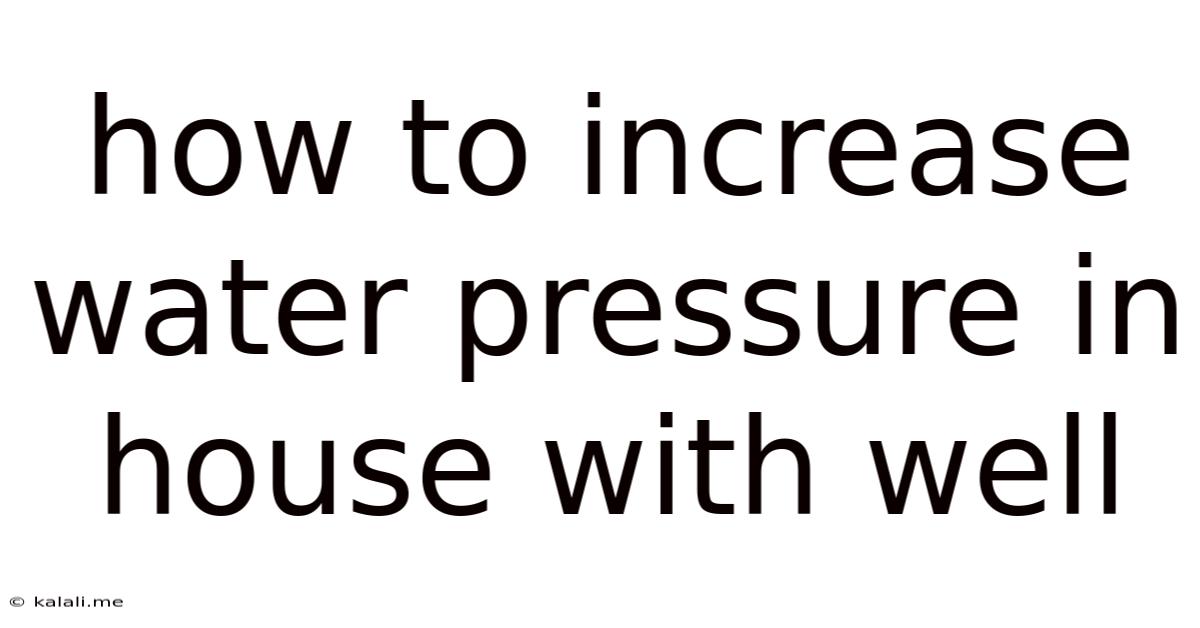How To Increase Water Pressure In House With Well
Kalali
Jun 10, 2025 · 3 min read

Table of Contents
How to Increase Water Pressure in a House with a Well
Having low water pressure in your home, especially when you rely on a well, can be incredibly frustrating. A weak shower, struggling faucets, and insufficient water for appliances are common symptoms. This article explores practical solutions to boost your well water pressure, helping you restore comfort and efficiency to your home. We'll cover both simple DIY checks and more involved potential solutions.
Understanding Low Well Water Pressure: Common Causes
Before jumping into solutions, it's crucial to understand why your water pressure is low. Several factors can contribute:
-
Well Pump Issues: This is often the culprit. A failing pump, worn-out impeller, or insufficient horsepower can all significantly reduce water pressure. Regular pump maintenance, including inspections and potential repairs or replacements, is essential.
-
Clogged Pipes: Mineral buildup, sediment, or corrosion within your pipes can restrict water flow, leading to reduced pressure throughout your house. This is particularly common in older homes.
-
Leaky Pipes: Even small leaks, often unnoticed, can dramatically lower water pressure. These leaks might be underground, within your walls, or even in visible fixtures. Regular inspections and prompt repairs are vital.
-
Air in the Lines: Air trapped in your water lines can interfere with water flow, resulting in inconsistent pressure. This is sometimes easily resolved with simple bleeding of the lines.
-
Problems with the Well itself: A dwindling water table, damaged well casing, or a poorly constructed well can all compromise water pressure. These issues require professional intervention.
DIY Solutions to Boost Well Water Pressure
Several simple steps can often resolve minor water pressure problems:
-
Check the Pressure Gauge: Your well pressure tank will usually have a pressure gauge. Compare the reading to the recommended pressure (usually printed on the tank). Low pressure indicates a need for adjustment or potential pump issues.
-
Bleed Air from the Lines: Air pockets can cause significant pressure drops. Open faucets throughout your home, starting with the highest points, to allow air to escape.
-
Inspect and Clean Aerators: Aerators in your faucets can become clogged with mineral deposits, restricting water flow. Removing and cleaning (or replacing) these small devices can often improve pressure.
-
Check for Leaks: Conduct a thorough visual inspection of all visible plumbing fixtures and pipes for any signs of leaks. Listen carefully for unusual sounds like hissing or dripping. Pay close attention to toilets, which are surprisingly frequent culprits for leaks.
Addressing More Serious Issues
If DIY solutions don't resolve your low water pressure, more significant problems likely exist:
-
Well Pump Repair or Replacement: A malfunctioning well pump often requires professional attention. A qualified technician can diagnose problems and perform necessary repairs or recommend a replacement based on your well's capacity and your household's water usage.
-
Pipe Repair or Replacement: If mineral buildup or corrosion is the cause, professional plumbing services might be needed to clean or replace affected sections of pipe. This is more costly but essential for long-term reliable water pressure.
-
Well Inspection: If the well itself is suspect, hiring a well drilling company for an inspection is necessary. They can assess the condition of the well casing, water level, and other crucial aspects to determine if any well-related issues are at play.
Maintaining Optimal Well Water Pressure
Preventing low water pressure is easier than resolving it. Here are essential maintenance tips:
-
Regular Pump Maintenance: Schedule annual inspections and servicing of your well pump. This helps catch minor issues before they escalate into major problems.
-
Annual Well Water Testing: Regular testing ensures that your water remains safe and free from contaminants that could affect your plumbing system.
-
Protect Your Pipes: Insulate exposed pipes to prevent freezing during cold weather, which can cause cracks and leaks.
By understanding the potential causes of low water pressure and following the steps outlined above, you can effectively diagnose and resolve issues, ensuring a consistent and reliable water supply in your home. Remember to always prioritize safety and contact qualified professionals when dealing with complex plumbing or well-related problems.
Latest Posts
Latest Posts
-
Write An Equation For These Two Complementary Angles
Jul 01, 2025
-
How Do You Beat Bloxorz Level 7
Jul 01, 2025
-
How Old Are You If Your Born In 1992
Jul 01, 2025
-
How Many Quarts Are In 15 Gallons
Jul 01, 2025
-
How Many Ounces Are In A Bag Of Flour
Jul 01, 2025
Related Post
Thank you for visiting our website which covers about How To Increase Water Pressure In House With Well . We hope the information provided has been useful to you. Feel free to contact us if you have any questions or need further assistance. See you next time and don't miss to bookmark.